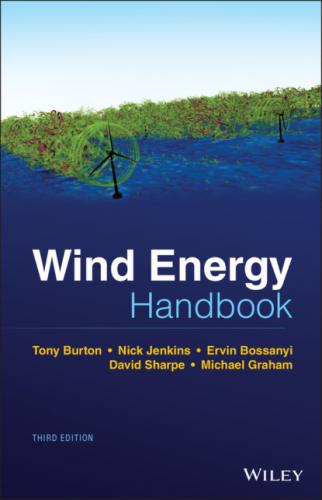9 Chapter 8Figure 8.1 Low‐speed shaft sensing system. Three proximity sensors mounted o...Figure 8.2 Main control loop for a fixed‐speed pitch‐regulated turbineFigure 8.3 Schematic torque‐speed curve for a variable‐speed pitch‐regulated...Figure 8.4 Use of a tower accelerometer to help control tower vibrationFigure 8.5 Effect of a drive train damping filterFigure 8.6 Comparison of pitch and stall controlFigure 8.7 A simple control algorithm for variable‐speed stall regulationFigure 8.8 Operating envelope for a variable‐slip generatorFigure 8.9 Effect of individual pitch control on rotating out‐of‐plane loads...Figure 8.10 Effect of individual pitch control on yaw moment. Top: without i...Figure 8.11 Effect of 1P and 2P individual pitch control on non‐rotating loa...Figure 8.12 Adding higher harmonic individual pitch control loopsFigure 8.13 Possible LiDAR scanning pattern: a five‐lobed cycloidal scan is ...Figure 8.14 Typical linearised turbine modelFigure 8.15 Simplified general model of plant and controllerFigure 8.16 Damping ratio for a complex pole pairFigure 8.17 Example root locus plot for a variable‐speed pitch controllerFigure 8.18 Pitch rate limit modification for a variable‐slip wind turbineFigure 8.19 Structure of the LQG controllerFigure 8.20 Limits applied to a PI controller
10 Chapter 9Figure 9.1 Diagram of the Jensen velocity deficit model.Figure 9.2 Typical Gaussian wake velocity profile from the Ainslie model.Figure 9.3 Wake steering control by yawing (schematic).
11 Chapter 10Figure 10.1 (a) Binned PDF of wind speed. (b) Power curve at each wind speed...Figure 10.2 Scatter plot for MCP.Figure 10.3 Example of an energy map (GWh/year) of a prospective wind farm s...Figure 10.4 Wind farm of six 660 kW turbines in flat terrain.Figure 10.5 Wind farm of 600 kW turbines at Tarifa, Spain.Figure 10.6 Wind farm of 700 kW turbines along a coast.Figure 10.7 Large wind farm on flat upland terrain.Figure 10.8 Example of ZTV (visual impact) of a wind farm. See Plate 4 for c...Figure 10.9 Example of wireframe showing visibility of three wind farms.Figure 10.10 Example of photomontage.Figure 10.11 (a) 3‐D view of a wind farm. (b) 3‐D view within a wind farm. (...Figure 10.12 Example of shadow flicker prediction. The continuous line shows...Figure 10.13 Noise contours around a small wind farm.Figure 10.14 Example of noise criterion proposed by the UKWorking Group on N...Figure 10.15 Example of noise criterion proposed by the UKWorking Group on N...Figure 10.16 Interference mechanisms of wind turbines with radio systems.Figure 10.17 Interference regions of a wind turbine.Figure 10.18 Illustration of first Fresnel zone (Fresnel ellipsoid).Figure 10.19 Example of areas where a wind turbine would mask radar.Figure 10.20 Evaluation of the impact of wind turbines on radar.
12 Chapter 11Figure 11.1 Large electric power system.Figure 11.2 Typical UK distribution transformer and earthing arrangements.Figure 11.3 Voltage control of a distribution circuit.Figure 11.4 Alternative locations of a transformer in a wind turbine.Figure 11.5 Protection circuitry of a wind turbine.Figure 11.6 Transformer and switchgear of 1.5 MW wind turbine.Figure 11.7 Unprotected GRP wind turbine blade damaged by a positive lightni...Figure 11.8 Blade lightning protection for a large wind turbine.Figure 11.9 Electrical power collection system of a wind farm.Figure 11.10 Schematic of a wind farm earthing system.Figure 11.11 Simplified typical protection scheme for a small wind farm conn...Figure 11.12 Typical shape of continuous and short‐time operating regions.Figure 11.13 Reactive power/power characteristics required in Great Britain....Figure 11.14 Reactive power/power characteristics required in two continenta...Figure 11.15 Commonly used reactive power compensators.Figure 11.16 Frequency response.Figure 11.17 Delta control of real power.Figure 11.18 Typical fault ride through characteristic.Figure 11.19 Additional control loops to provide synthetic inertia to a vari...Figure 11.20 Illustration of generation adequacy.Figure 11.21 Generation merit order, showing the effect of increasing wind g...Figure 11.22 Flows of information in a wind power forecasting tool.Figure 11.23 Origin of power quality issues. (a) Disturbances originating in...Figure 11.24 Influence of frequency on the human perception of sinusoidal vo...Figure 11.25 Principle of flicker measurement (IEC 61400‐4‐15 2008b).Figure 11.26 Use of a fictitious grid to establish voltage variations for va...Figure 11.27 Harmonic equivalent circuit of a VSC based wind turbine generat...Figure A11.1 Fixed‐speed wind turbine on a radial circuit.Figure A11.2 Example of calculation of voltage rise on a redial circuit (all...
13 Chapter 12Figure 12.1 Offshore wind farm capacity. (a) Offshore wind farm capacity wor...Figure 12.2 Lillgrund wind farm layout. Lillgrund Pilot Project (2009a).Figure 12.3 Lillgrund wind farm: variation in array efficiency with wind dir...Figure 12.4 Variation of turbulence intensity
